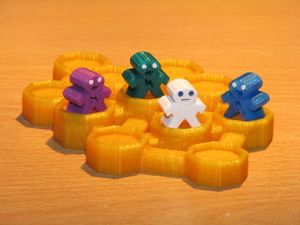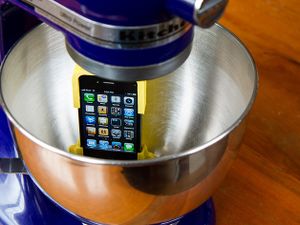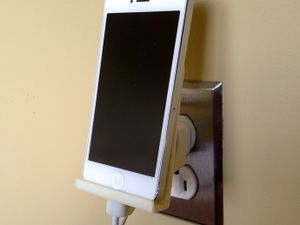User:Jlm5940/Blog
This page contains my blog submissions for EDSGN 497J. Enjoy!
Contents
Blog 1: Thingiverse Designs
Due: 1/22/14
Blog Description: "Go to thingiverse.com and look for printable objects, which other people have actually printed, finding designs which satisfy these descriptions in your mind: something amazing/beautiful, something funny or strange, something useless, something useful, something which surprised you".
Something Amazing/Beautiful
Elephants are my favorite animal, and I love the style of this necklace. I think that the fact that even the chain is printed is pretty amazing. I would probably actually wear this.
Something Funny or Strange
Apparently this is an old game, but I had never heard of it! The little zombie figures made me laugh, mostly because of their facial expressions. Maybe I'll look into how this game works!
Something Useless
I honestly cannot think of a single real use for this accessory. If you watch the YouTube clip they take a video on the phone while the mixer is going, and this is the only purpose I believe this could serve. Using your iPhone to mix ingredients would obviously ruin it. I did enjoy one of the comments on the picture that said "this is what Bill Gates uses to make cookies". It also come with a headphone jack in case you were worried that you couldn't listen to music while your iPhone is being destroyed!
Something Useful
My apartment always seems to lose "chip clips", or we never have enough to go around. Being able to print a bunch of them would be very useful for us. It seems like a fairly simple design, so maybe one day I will be able to make these!
Something Which Surprised You
I didn't really know anything about 3D printing before this class. The reason why this iPhone dock surprised me is because I would have never guessed that something like this could be 3D printed. The fact that functioning technology accessories such as this can be made is incredible, and could save people tons of money.
Blog 2: Open Source Ecology
Due: 2/1/14
Blog Description: "Marcin was just here at PSU talking about his Open Source Ecology project. You may notice or suspect that 3D printers are on his list of systems which should be included in the toolkit. Respond to the following:"
A) "I want your general impressions of the OSE project; positive, negative, utopian, etc. Please do a bit more research than just viewing the video, as it is now several years old and they have made some progress since then. Links to more recent videos and media will earn you a better blog."
After watching Marcin's TED talk , and several more recent videos of his project's progress, I still find myself having a very torn opinion on his Global Village Construction Set (GVCS) idea. Our society is definitely already entering a recycling and DIY craze. There are several websites and blogs out there that can show the average person how to hand make many everyday items from things that they would already have in their own home or could purchase at a very small cost. Because of this, it is obvious that Marcin's project will become more and more popular. Personally, I think that learning to make what you need on your own is a great idea. It will not only save people a lot of money, but also give them the opportunity to make something that will specifically fit their needs. Marcin first began with making a tractor after his kept breaking down, and building his own that was more durable (and much cheaper) saved him tons of money. I think that using his GVCS for helping third world countries, as he mentioned was one potential use, is a good idea. I do see several problems for the future of this project, however. First of all, Marcin describes the GVCS as a "DIY open source platform that allows for the easy fabrication of the 50 industrial machines that it takes to build a small civilization with modern comforts". I think that when it comes to building machinery, the average person would not consider them to be DIY, easy to fabricate projects. Even as a fairly intelligent person, myself, that is about to graduate with a degree in Mechanical Engineering, a project like this would likely take me a long time with the help of several people. Average people do not have the machining skills required to build any of the GVCS machines. Another problem I foresee, is how it would affect our economy. If everyone would someday begin building all of their own products, it would run so many companies out of business, eliminating millions of jobs. It would, however, save people lots of money. There are so many pros and cons to Marcin's ideas, and quite frankly I cannot pick a side. I think that the best idea, right now, would be for him and his team to continue building these machines and try to use them to start up communities in struggling areas.
B) "The New Yorker magazine recently had a fairly critical article regarding Marcin's OSE project. Find/link that article and summarize its critique. Marcin had a response to that: I'd like your response to both of these pieces."
Emily Eakin's article, "The Civilization Kit", from The New Yorker both summarizes and criticizes Marcin's GVCS start up and progress thus far. She says that his "following" are more enthusiasts than experts. Another criticism is that his Factor e Farm has no kitchen or bathroom, and barely produces any food. The article then begins to tell the history of Marcin's Open Source Ecology (OCE) ideas. After receiving his PhD, Marcin started the OCE website "with the aim of collecting the best techniques for creating sustainable communities". Marcin and his girlfriend bought a farm and built their own hut to live in. After his tractor repeatedly broke down, he decided to build his own, and quickly realized that he could build everything that he needed in his life. That was the beginning of his GVCS projects. Since then, Marcin has gained quite a following, given an extremely popular TED talk, and inspired others to try to build their own machines. Marcin's goal is to get to the point where he can build a tractor a day.
I don't really think that her article did Marcin's projects any justice. While, it is a news article and they usually focus on the negatives, she didn't even focus on the project as much as she did his personal life. Obviously, the GVCS will cause some controversy, but it seemed as though Eakin was trying too hard to find problems that don't actually exist. The fact that his farm doesn't produce and food, or have a kitchen or bathroom doesn't really matter. From what I have gathered, it's main purpose is a space where Marcin and the Factor e Farm workers can work on building their machines. There are moments where she seemed to praise Marcin's progress, but also tear him down, so I can't quite pinpoint her stance.
Marcin's response to the article basically just defended himself, and his work, in each area that Eakin targeted. I think that he did a good job further describing how they started, what their intentions are, and where they hope to go from here. He explains everything from how the article's title is misleading to how they are bettering the quality of the Factor e Farm's site. As I stated above, I agree with him that Eakin focused too much on his personal life, and the negative outcomes of his work. I don't know that I would go as far as him to say that this Open Source Ecology idea is more critical than trying to end war and environmental injustice, but I do believe that it could help a lot of people.
C) "Imagine we want to create capabilities similar to what Marcin has made at PSU (something like an OSE student club, or another effort). I don't think the administration or trustees would support such a thing, but there might be professors who are interested in supporting such a thing. Do you know any of them? What do they do, and why do you think they would be interested in such a project? Imagine you are looking for allies to do such a thing. Whom is on your list and why?"
If an OSE club was created here at PSU, I think that there would definitely be student interest. I think that the biggest problem would be to get the materials or funding for the projects, and, at first, I don't see the club actually doing too much each year. Even though Marcin and his team can now assemble his designs in a matter of days, college students are very busy so I think it would take students longer. Getting access to the space and machines would also be an obstacle since there are limited shops to work in (The Learning Factory and Leonard Building being two bigger ones for students to use). I believe that there would definitely be professors interested in support an organization like this. I don't know any that have specifically expressed interest in this area, but professors that have already taken an interest in 3D printing would probably be interested.
Blog 3: Kansas Teen Uses 3-D Printer to Make Hand for Boy
Blog Description: "Read and respond to this. Who created this design and when/where was it done? If you wanted to make one, where would you go to get it? How many news articles can you find which reference this technology?"
This design was originally created by Ivan Owen (theatrical artist who makes parts for puppets) and Richard Van As(a woodworker). Van As came up with the idea after he lost a finger and parts of other fingers during a workshop accident. He wanted a new finger, but didn't want to pay for an expensive prosthetic, so he contacted Owen for help. A mother in South Africa contacted the men, and asked them to build a hand for her son. The Robohand prototype was completed in November of 2012, and the 3-D printer version in January 2013. Designs for this Robohand are open to the public, and can be found on Thingiverse.
I found several related articles after searching "3-D printed prosthetics" online. One article by the Huffington Post details a similar situation to the one above. This article is about a father that used Owen and Van As as inspiration and printed a hand for his 12 year old son that was born without fingers on his left hand. Another article that I found was from gizmag and features a 17 year old boy, Easton LaChappelle, that created a very advanced 3-D printed prosthetic arm and hand. This invention allowed him to participate in the White House Science Fair, and present his design to President Obama. LaChappelle hopes that his design can be used to help amputees. He was even invited to speak at a TED conference, and the video of his talk can be found here. Finally, I found what I believe to be the most interesting article: 3-D printed eyes. [1] Dezeen magazine's website highlights the British company Fripp Design and Research who claims to be able to print up to 150 eyes per hour. The iris and blood vessels are already included in the printing process, so it eliminates the time it would take for someone to actually paint each eye, which is the current practice. So far, the company has received a lot of interest from India where surgical procedures are not advanced and people are unable to afford expensive prosthetics.




